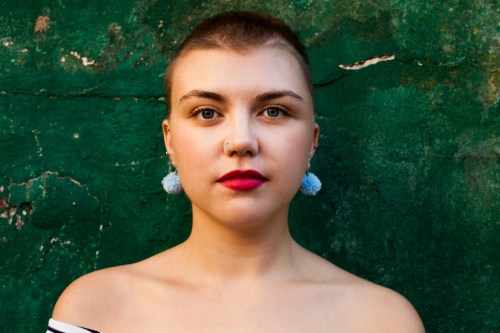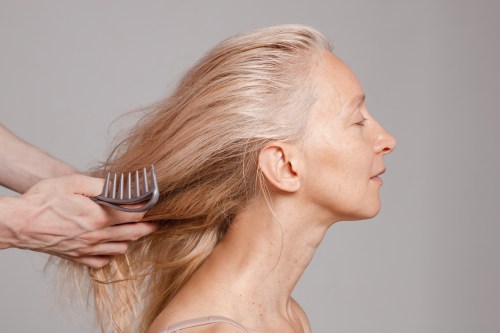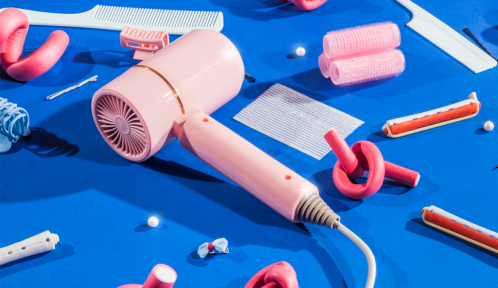Our editors independently select these products. Making a purchase through our links may earn Well+Good a commission
How to Remove Facial Hair at Home, According to the Pros
Experts reveal everything you need to know about how to remove facial hair, and the eight different methods you can DIY at home.

If you’ve ever peered into a magnifying mirror, you’ve probably noticed peach fuzz on places like your cheeks, jawline, or upper lip—and that’s completely normal. We’re mammals and all mammals have hair. For those who want to get rid of these strands, experts are sharing their tips on how to remove facial hair through all different methods.
Experts in This Article
European Wax Center education manager.
board-certified dermatologist with Riverchase Dermatology
brand expert and ambassador at Nad’s
Esthetician and skin-care pro with Flaunt Body.
“The upper lip and chin area are very common for most women to have hair growth, and many seek a means of hair removal,” says Gina Petak, education manager for European Wax Center, adding that light hair growth on the sides of the face is also common. To get rid of this fuzz and hair, you’ve got a long list of facial hair removal methods you could turn to, including tweezing to waxing, shaving, threading… and the list goes on. Keep scrolling for your ultimate guide.
How to remove facial hair
1. Shaving
One of the easiest DIY methods of facial hair removal is zipping hair off with a razor, but it’s not exactly the same thing as shaving your legs. “The most important thing to remember about shaving facial hair is to shave in the direction of hair growth,” says Tiffany Tramaine, esthetician and skin-care pro for Flaunt Body. If your hair is coarse or curly, she points out that it can grow in several directions, so if shaving in one way is difficult or painful, switch directions. “You may have to shave in one direction on one part of the face and another direction for a different area,” she says.
As is the case with shaving any other part of your body, prepping your skin beforehand is key. “Steaming is a great way to soften the skin around the hair follicle for a cleaner shave,” says Tramaine. “You could also prep with a non-comedogenic oil to soften the hair shaft.” Her faves to use? Almond and grapeseed oils. And, of course, make sure that your tools are clean.
Best for: Normal to oily types, says Traimaine.
Pain level: According to Tramaine, there should be minimal to no pain if done correctly.
After care: Moisturize, but stay away from anything with alcohol (which can irritate just-shaved skin).
2. Tweezing
Tweezing is another common DIY facial hair removing option, but it’s best for eyebrow hair. Since facial skin is very sensitive, it’s important to use the right pair of tweezers (and the proper technique) so that you don’t cause too much pain. “Not all tweezers are made the same,” says Tramaine. “If you notice that your pair is not doing the job or if it’s breaking the hair shaft, it’s time to update your tweezers.”
The goal with tweezing is to pull the entire hair out, which means that you should be getting the bulb at the base of the shaft. Her recommendation is to use tweezers with a slant—not a point—for more precision, and for a smaller chance of nicking your skin. That said, Petak suggests only cleaning up your upper lip area with tweezers (not removing all of the hair there) since it’s an extra-sensitive area.
Also, tweezing works best if you have enough hair to work with. “If you want better results from tweezing, you need to go longer between tweezing and letting the hair grow out—if you pluck too soon, it will only grow back faster,” says Tramaine. To prep the area for a good tweeze, Petak recommends washing and exfoliating the skin beforehand. “This ensures that all dead skin is removed and will allow for the closest tweeze,” she says. To minimize pain and make the plucking easier, hold your skin gently with one hand as you tweeze with the other.
Best for: All hair types, according to Tramaine.
Pain level: Tramaine says it’s a pain level of zero to three, and “not much more than a slight sting.”
After care: Slather on a soothing moisturizer or gel like the European Wax Center Mask Me Hydrogel Mask ($10).
3. At-home waxing
Though having facial hair professionally waxed for removal, you can do it on your own with the right products and setup. “Waxing will give you long-lasting results,” says Tramaine, who notes that there’s a wax product out there for every hair type. According to Natalie Ismiel, brand expert and ambassador at Nad’s, you should apply wax in the direction of hair growth, then pull the strips or hard wax in the opposite direction for the best results. “Make sure that you hold the skin very taut, then pull the wax off in the opposite direction, which ensures that the hair is lifted swiftly and comfortably at the root,” she says.
Since the skin on the face is more delicate than that on the body, Ismiel recommends using facial wax strips for the most effective and painful hair removal. Try something like Nad’s Facial Wax Strips ($5) or the Flamingo Face Wax Kit ($10). Before you get started, though, check your skin-care routine to make sure nothing has made your skin more sensitized to waxing. “If you are using topical products with exfoliators like AHAs, BHAs, or retinoids, be mindful because lifting can occur, which is when you rip the top layer of the skin off,” says Tramaine.
You’ll know that this occurred if your skin is red, shiny, and painful to the touch right afterwards. “For people who have acne, you should be especially careful if you’re actively treating it in your routine because chances are that you’re using one of these sensitizing products.” If you’re using an antibiotic for combatting acne, check with your doctor before waxing to make sure it’s safe for your skin.
Best for: Everyone except for those with sensitive skin types. “They should avoid waxing all together and check the ingredients of the wax for allergens,” says Tramaine.
Pain level: This can be zero to five, depending on if you have previous waxing experience.
After care: First off, avoid touching the area to ensure any oils or bacteria don’t irritate the skin, says Ismiel. You can apply a calming oil or moisturizer, or a cold compress if there’s a little burning sensation.
4. Epilation
An old-school hair removal tool that’s still beloved by French women, the epilator can pluck away facial hair like an en masse tweezer. But it’s not as universally safe for all hair types. “I don’t recommend these for coarse hair or for men,” says Tramaine. “This type of machine is best for peach fuzz-type hairs. Any other hair type can run the risk of irritation, ingrown hair, pimples, and scarring.” Her take? The epilator doesn’t offer much precision at all. “It is a machine that pulls many hairs out at once,” she says.
Best for: Really fine peach-fuzz hair.
Pain level: Tramaine puts epilation at a 10.
After care: If you’re going to use this method for hair removal, apply a soothing, aloe vera or chamomile extract-rich moisturizing cream onto your skin afterwards.
5. Depilatory cream
A depilatory cream can help to remove unwanted hair with a simple slather. “These are formulated to dissolve unwanted facial hair in as little as four minutes,” says Ismiel. If you choose the right one, she notes that it can effectively remove hair close to the root for smooth results that last longer than shaving. Lucy Chen, MD, a board-certified dermatologist with Riverchase Dermatology in Miami, says that many formulations exist to treat different body areas.
That said, if your skin tends to be reactive, both Tramaine and Dr. Chen recommend using a different method. “A depilatory is a chemical, and there are so many different factors that can affect its efficacy and your skin’s reaction,” says Tramaine. Dr. Chen recommends testing on a small patch of skin first since they can cause irritation. For best results, she suggests applying your cream after the shower when the skin is more hydrated. “Make sure to avoid using those products labeled for body hair on facial hair and vice versa, as the formulation can be stronger for body hair,” she says.
Best for: Fine hair types.
Pain level: Zero to one when you use it, but Tramaine says that this can reach a much higher number if your skin gets irritated. Note: these often have a strong smell.
After care: If irritation occurs, Dr. Chen recommends applying cortisone cream to combat inflammation.
6. Threading
Threading actually involves a cotton or polyester-based thread that rolls over unwanted hair to pluck it out. Tramaine points out that it’s a traditional hair removal method in many Middle Eastern countries. “Like tweezing or using an epilator, the thread wraps around the hair and pulls the shaft from the root,” she says. Typically, she’d recommend leaving this method to the professionals. “It can cause a lot of frustration trying to get that perfect angle,” she says. For your best results, make sure that skin is well moisturized so that the thread can glide smoothly across the skin.
Best for: Dark, thick, or coarse hair, says Tramaine, who notes that it’s also good for normal to oily skin types.
Pain level: Tramaine ranks threading at a one to six depending on your pain tolerance.
After care: Dr. Chen advises to avoid topical retinoids and acids a few days prior to and after threading to prevent excess irritation. Stick with gentle skin-care cleansers and moisturizers afterwards.
7. Topical prescription
There is one prescription-based option for removing facial hair: eflorinithine hydrochloride. “It’s the only prescription hair removal product that slows down and eliminates hair growth,” says Dr. Chen. “The medication works by affecting the stem cells in the hair bulb and stopping the hair growth.” It takes several months to work, and is typically used in between laser hair removal treatments to slow down hair re-growth.
Best for: Those who are not pregnant.
Pain level: “There may be some mild burning with topical application and the potential for acne,” says Dr. Chen.
After care: A gentle skin-care routine.
Sign Up for Our Daily Newsletter
Get all the latest in wellness, trends, food, fitness, beauty, and more delivered right to your inbox.
Got it, you've been added to our email list.










